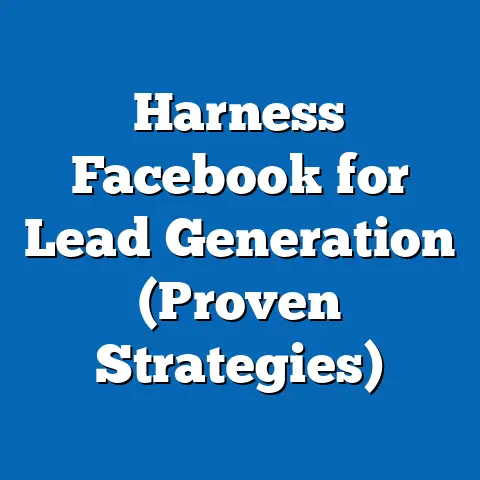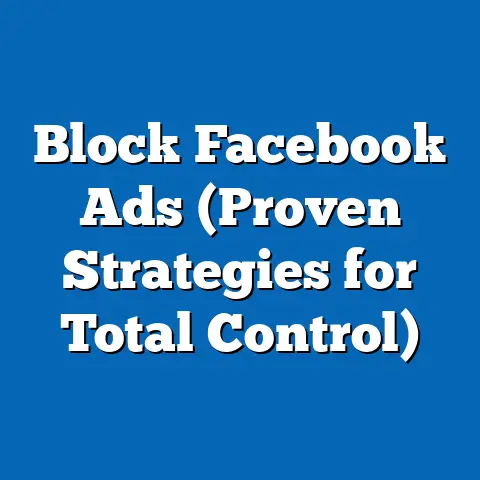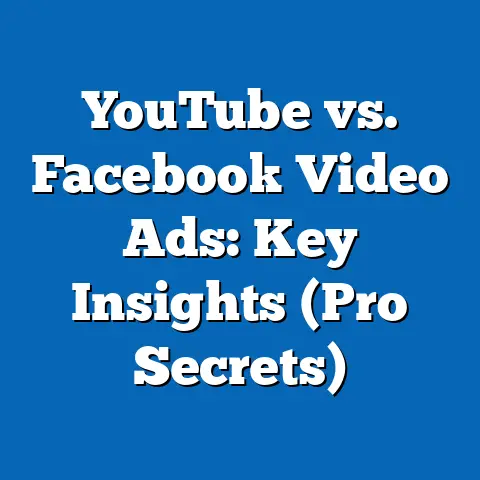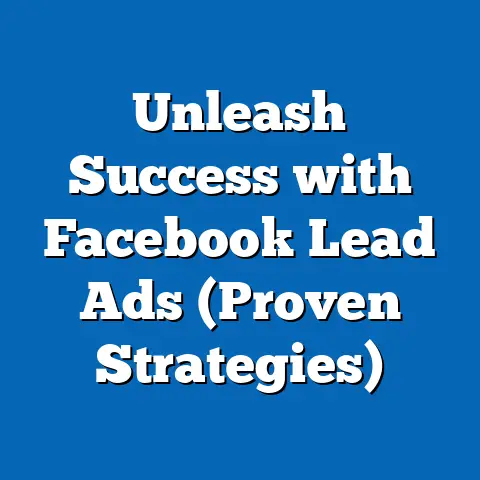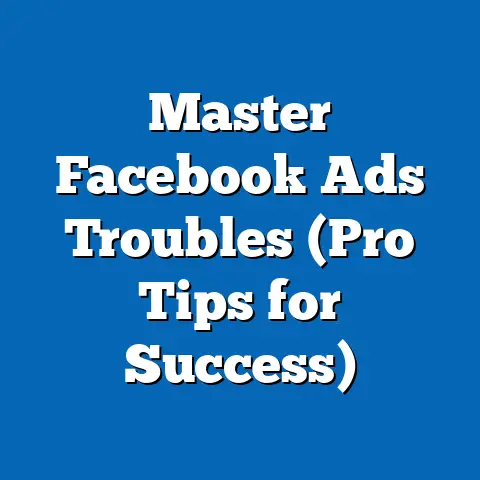Maximize ROI with Facebook Ad Lib (Proven Strategies)
In today’s fast-paced, digitally driven world, individuals across generations lead increasingly busy lives, juggling work, family, personal growth, and social connections. This frenetic pace, often exacerbated by the constant influx of information and the pressure to stay connected, has created a unique environment where businesses must adapt to capture attention effectively. For marketers, understanding how to maximize return on investment (ROI) through tools like the Facebook Ad Library is not just a strategy—it’s a necessity to cut through the noise and reach audiences who are perpetually on the move.
The Context of Busy Lives: Defining Characteristics and Historical Shifts
The concept of “busy lives” transcends generational boundaries, yet it manifests differently across age groups due to varying responsibilities, technological engagement, and societal expectations. For Millennials (born 1981–1996), busyness often stems from balancing career progression, student debt, and the gig economy’s unpredictability, while Gen X (born 1965–1980) grapples with mid-career demands and caregiving for both children and aging parents. Gen Z (born 1997–2012), on the other hand, faces the pressure of academic competition, social media overload, and early career uncertainty, all while being digital natives who are constantly connected.
Historically, the acceleration of busyness can be traced back to post-World War II economic booms, particularly in Western societies, where the rise of dual-income households and consumer culture increased demands on time. The advent of the internet in the 1990s and the smartphone revolution in the 2000s further intensified this trend, creating a 24/7 culture of availability and productivity. According to a 2019 study by the American Psychological Association, 60% of U.S. adults reported feeling stressed due to time constraints, a figure that has only grown with the rise of remote work and blurred work-life boundaries post-COVID-19.
Societally, the implications of busy lives are profound, influencing mental health, family dynamics, and consumer behavior. People now prioritize efficiency and convenience, seeking products and services that save time or enhance productivity. This shift has direct relevance for marketers, as attention spans have shortened—research by Microsoft in 2015 estimated the average human attention span at just 8 seconds, down from 12 seconds in 2000. For businesses, this means advertising must be immediate, impactful, and highly targeted, setting the stage for tools like the Facebook Ad Library to become indispensable.
The Facebook Ad Library: A Tool for the Modern Marketer
Launched in 2019 as part of Meta’s transparency initiatives, the Facebook Ad Library is a publicly accessible database that archives all active ads running on Facebook and Instagram. Initially designed to provide insight into political and social issue ads, it has evolved into a powerful resource for marketers seeking competitive intelligence and creative inspiration. With over 2.8 billion monthly active users on Facebook as of 2023, the platform remains a dominant advertising space, making the Ad Library a goldmine for understanding what resonates with audiences.
For marketers operating in the context of busy lives, the Ad Library offers a way to analyze how competitors capture fleeting attention. It allows users to search ads by keyword, advertiser, or topic, revealing details like ad copy, visuals, targeting demographics, and engagement metrics in some regions. This transparency is particularly valuable when crafting campaigns for time-strapped audiences who demand relevance and immediacy.
However, maximizing ROI with the Ad Library requires more than just browsing ads—it demands a strategic approach informed by data and an understanding of generational and societal trends. The following sections outline proven strategies, grounded in research and practical application, to leverage this tool effectively while addressing the unique challenges of reaching busy consumers.
Strategy 1: Competitive Analysis for Targeted Relevance
One of the most powerful uses of the Facebook Ad Library is competitive analysis, which enables marketers to identify what works in their industry and adapt accordingly. Busy consumers, regardless of generation, are more likely to engage with ads that feel personalized and relevant to their immediate needs. A 2022 study by McKinsey found that 71% of consumers expect personalized interactions, and 76% get frustrated when they don’t receive them.
To apply this strategy, start by searching for competitors’ ads using relevant keywords or brand names in the Ad Library. Analyze their messaging—do they emphasize time-saving benefits, emotional resonance, or value for money? For instance, a meal delivery service targeting busy Millennials might highlight “dinner in 15 minutes,” while a financial app for Gen X could focus on “secure your family’s future in one click.” Note the visuals and calls-to-action (CTAs) as well, as these elements often determine whether a user stops scrolling.
Beyond direct competitors, explore ads in adjacent industries to uncover cross-applicable trends. A 2021 report by Hootsuite noted that 54% of social media users discover new products through ads, often from unexpected sectors. By studying engagement patterns—visible in some regions through likes, shares, and comments—marketers can refine their targeting to align with what busy audiences respond to most.
Strategy 2: Creative Inspiration to Cut Through the Noise
In a world where busy individuals are bombarded with content, creativity is key to standing out. The Facebook Ad Library provides a repository of real-world examples, showcasing how top brands craft compelling visuals and copy. This is particularly crucial given that, according to a 2023 Nielsen report, 47% of consumers ignore ads unless they are visually striking or emotionally engaging.
When using the Ad Library for inspiration, focus on ads with high engagement and analyze their structure. Are they using short, punchy videos—ideal for Gen Z’s preference for quick content—or detailed infographics that appeal to Gen X’s analytical mindset? Look for storytelling elements that connect with the audience’s lifestyle; for example, an ad for a productivity app might depict a harried parent managing tasks, resonating with the daily grind of busy lives.
Importantly, avoid direct copying, as authenticity matters to modern consumers. A 2020 Edelman Trust Barometer report revealed that 64% of consumers value brands that are genuine in their messaging. Use the Ad Library to identify trends—such as the rise of user-generated content or minimalist design—and adapt them to your brand’s unique voice.
Strategy 3: Audience Insights Through Ad Targeting Analysis
Understanding who competitors are targeting is another critical advantage of the Facebook Ad Library, especially when reaching busy demographics with limited time for irrelevant content. While the tool doesn’t provide granular targeting data for all ads, it often includes information on geographic regions, languages, and occasionally demographic interests for political or social issue ads. This can offer clues about audience segmentation.
For instance, if a competitor’s ad is running in urban areas with high concentrations of working professionals, it suggests a focus on busy, career-driven individuals—likely Millennials or Gen X. Marketers can then tailor their campaigns to address similar pain points, such as offering solutions for time management or stress relief. Pairing this with Facebook’s own Audience Insights tool can further refine targeting, ensuring ads reach the right people at the right time.
This strategy is particularly effective given the generational diversity in how busyness manifests. A 2022 Pew Research Center study highlighted that 68% of Millennials feel overwhelmed by work-life balance, compared to 55% of Gen X and 73% of Gen Z. By aligning ad targeting with these nuances—perhaps focusing on career tools for Millennials and mental health resources for Gen Z—marketers can maximize relevance and ROI.
Strategy 4: Timing and Frequency Optimization
Busy lives mean limited windows of attention, making the timing and frequency of ads critical to success. While the Ad Library doesn’t directly show scheduling data, it can reveal patterns in when competitors launch campaigns or increase ad frequency, especially around holidays or major events. For example, a spike in fitness ads in early January likely targets New Year’s resolutions, a time when even the busiest individuals prioritize self-improvement.
Research by Sprout Social in 2023 indicates that the best times to post on Facebook vary by audience: weekdays from 9 AM to 3 PM often work for professionals (Gen X and Millennials), while evenings suit younger users (Gen Z). Use the Ad Library to monitor competitors’ active ad durations—long-running ads may indicate sustained relevance, while short bursts could signal event-driven campaigns—and test similar timing in your strategy.
Frequency is equally important, as overexposure can annoy busy users. A 2021 study by Kantar found that 62% of social media users feel frustrated by seeing the same ad repeatedly. Balance visibility with restraint, using insights from the Ad Library to gauge how often competitors refresh creative or rotate messaging.
Strategy 5: Benchmarking Performance and Iterating
Maximizing ROI requires continuous improvement, and the Facebook Ad Library facilitates benchmarking by allowing marketers to compare their ads against industry standards. While engagement metrics aren’t universally available, visible data in some regions can provide a baseline for likes, shares, and comments. If a competitor’s ad garners significant interaction with a specific CTA, such as “Shop Now,” test a similar approach while monitoring your own performance.
Iteration is key in a landscape where busy consumers’ preferences shift rapidly. A/B testing, informed by Ad Library insights, can help identify what resonates—whether it’s a humorous tone for Gen Z or a practical solution for Boomers (born 1946–1964). According to a 2022 HubSpot report, 81% of marketers who use data-driven iteration see improved campaign performance, underscoring the value of this approach.
This strategy also ties into the broader societal trend of data overload in busy lives. Consumers are more discerning, quickly dismissing ads that don’t deliver value. By benchmarking and iterating, marketers ensure their campaigns remain agile, adapting to feedback and trends in real time.
Societal and Workplace Implications of Digital Advertising in Busy Lives
The use of tools like the Facebook Ad Library reflects broader societal shifts driven by busyness and digital saturation. On one hand, targeted advertising can enhance convenience, connecting time-strapped individuals with solutions they need—think quick grocery delivery for a busy parent or online learning for a career-focused Millennial. On the other hand, it raises concerns about privacy and mental health, as constant ad exposure can contribute to stress and decision fatigue.
In the workplace, the implications are equally significant. Marketers and business leaders must navigate a workforce that mirrors these busy demographics, balancing employee well-being with the demand for high-performing campaigns. A 2023 Gallup poll found that 44% of employees feel burned out due to workplace demands, a challenge that extends to marketing teams tasked with mastering tools like the Ad Library under tight deadlines.
Moreover, generational differences in tech adoption impact how advertising strategies are implemented. Gen Z and Millennials, as digital natives, may embrace data-driven tools more readily, while Gen X marketers might prioritize proven methods over experimentation. Bridging these gaps through training and collaboration is essential for maximizing ROI across diverse teams.
Cultural and Economic Factors Influencing Ad Effectiveness
Culturally, the perception of busyness varies, affecting how ads are received. In individualistic societies like the U.S., busyness is often tied to status and productivity, making ads that promise efficiency particularly appealing. In contrast, collectivist cultures may respond better to messaging around family or community benefits, even amidst busy schedules.
Economically, the financial pressures of busy lives—such as rising costs of living and stagnant wages for many Millennials and Gen Z—mean value-driven ads often outperform luxury-focused ones. A 2022 Deloitte survey noted that 63% of consumers prioritize affordability over brand loyalty, a trend visible in Ad Library data where discount offers frequently see high engagement.
These factors underscore the importance of context in advertising. The Ad Library provides a window into how competitors address cultural and economic realities, offering lessons for crafting campaigns that resonate with busy, cost-conscious audiences.
Forward-Looking Insights: The Future of Advertising in a Busy World
As busyness continues to define modern life, the role of tools like the Facebook Ad Library will only grow. Emerging technologies, such as AI-driven ad optimization and augmented reality experiences, are likely to integrate with platforms like Facebook, offering even deeper insights into consumer behavior. However, uncertainties remain—will privacy regulations limit data access, or will consumer fatigue lead to ad avoidance?
Marketers must stay adaptable, using the Ad Library not just as a tactical tool but as a lens into evolving societal trends. The balance between personalization and intrusion will be critical, especially as busy individuals demand relevance without sacrificing autonomy. Collaboration across generations, leveraging diverse perspectives on busyness, will also shape future strategies.
In conclusion, maximizing ROI with the Facebook Ad Library is both an art and a science, requiring a deep understanding of busy lives and the generational, cultural, and economic forces that shape them. By employing proven strategies—competitive analysis, creative inspiration, audience insights, timing optimization, and iterative benchmarking—marketers can navigate this complex terrain. As we look ahead, the challenge will be to innovate responsibly, ensuring that advertising enhances rather than overwhelms the lives of those it seeks to reach.

